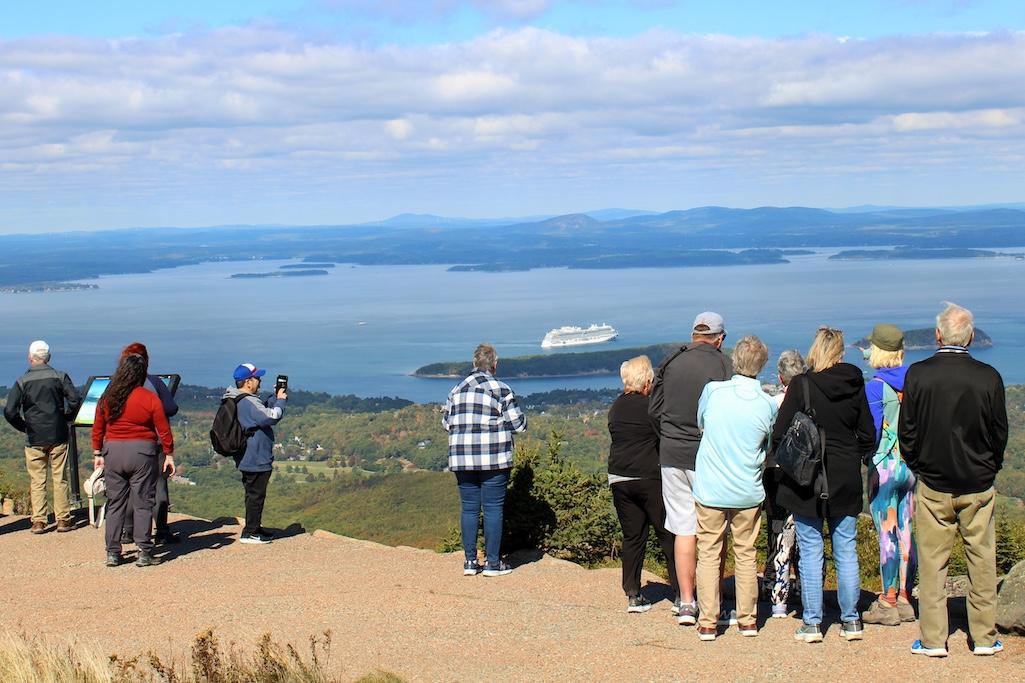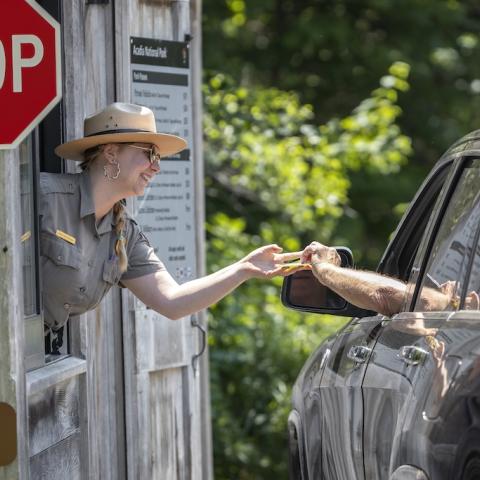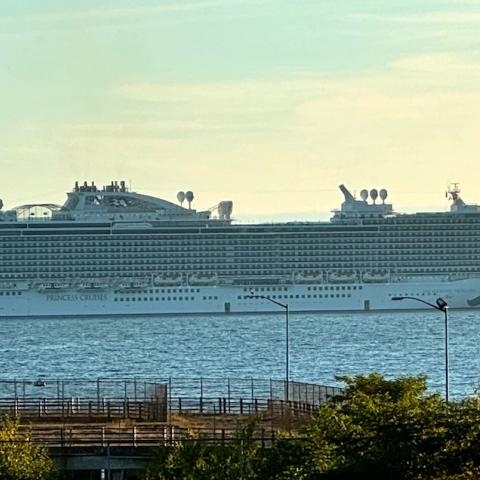The waterfront of Bar Harbor, Maine, was quiet at 7 a.m. on a warm, late-September day that saw the 1,082-foot-long Enchanted Princess, a cruise ship carrying more than 3,000 passengers, anchored in Frenchman Bay.
But an hour later small boats began ferrying several dozen passengers at a time from the ship to the dock where they were greeted by a clutch of security personnel, buses, and vans that would take them around Mount Desert Island and Acadia National Park. Within hours, hundreds of people filled the downtown streets, perusing shops, waiting to enter restaurants and bakeries, renting bicycles, and boarding electric vans.

Passengers from the Enchanted Princess cruise ship walk toward downtown Bar Harbor from a tender that escorted them to a pier on September 24/Marcus Wolf
The daylong excursion, one repeated more than 100 times a year, is viewed as both bounty and burden in Bar Harbor, where the ships’ passengers boost the town’s economy but leave some locals worried that they’re losing control over their hometown.
Russell and Jenny Sorensen from Salt Lake City, Utah, were among the thousands of Enchanted Princess passengers who arrived on that September day. After disembarking, they strolled along West Street, home to luxury hotels, seafood restaurants, cafés, and gift shops, as well as scenic views of the Mount Desert Narrows and nearby islands. While taking in the sights and capturing photos, Russell Sorensen said he thought town residents looked upon them with intrigue as they marveled at what are everyday surroundings for locals.
The Enchanted Princess, owned by a subsidiary of Carnival, promotes various excursions throughout Acadia and Bar Harbor, including bus trips up Cadillac Mountain and along Acadia’s coast, lobster bakes, sailing, whale watching, and Victorian-themed history tours in town. The Sorensens, however, set out on their own adventure of cycling around Acadia, particularly the bucolic, motor-vehicle-free carriage roads that John D. Rockefeller Jr. had built between 1913 and 1940, enjoying the rolling, leafy, and well-preserved landscapes.
“I read a lot of books set in Maine, and I always wanted to see the place,” Jenny Sorensen said. “Anything we see here, I’m happy with.”
How Many Are Too Many?
Bar Harbor, the main gateway to Acadia, welcomes more than 100 ships like the Enchanted Princess each year, with expected passenger counts ranging from 200 to more than 4,000, according to the portcall.com cruise ship schedule. Before the global COVID-19 pandemic halted cruise ships in 2020, annual visitation from passengers jumped about 1,000 percent in Bar Harbor, from 25,485 across 39 ships in 1999 to 254,546 on 176 ships in 2019, according to a report by Operations & Maritime LLC commissioned by the Cruise Line Industry Association at the town’s request.
The ships ferry an economic boom of sorts to the town. According to a report compiled by University of Maine researchers, in 2016 passengers from 115 ships spent an estimated $15 million in Bar Harbor, dollars that helped support more than 300 jobs.
And yet, the high number of cruise ship passengers visiting Bar Harbor is a controversial matter among the people who live and work in the town. It has also been the subject of multiple lawsuits, both to repeal the current limit on cruise ship numbers and to uphold it; at least one reported violation alleging the lack of a permit by one business to allow ships to drop off their passengers on its property; and referendums, including one scheduled during the general election on November 5 that — barring more legal challenges — will affect when and how many passengers will be allowed to disembark in town, whether there should be blackout dates for the ships, and monthly caps, among other things.
National Park Service officials at Acadia are not involved in regulating cruise ships, but they are exploring management options, such as issuing concession contracts for businesses that bring passengers into the park, that could affect a variety of visitors.
“We are indirectly involved with cruise ships because they do generate a certain level of commercial use,” John Kelly, management assistant for Acadia, said during a phone call. “We absolutely don’t have any stance on how the town and residents of Bar Harbor manage cruise ships.”
In the eyes of Charles Sidman, who’s lived in Bar Harbor for 40 years, cruise ships have been an issue for many years. When larger vessels bring thousands of passengers to visit, he said they “totally swamp our downtown area,” making it difficult to walk down the sidewalks and making shops inaccessible.
Sidman isn’t alone. In 2021, the consulting firm Pan Atlantic Research wrote a report commissioned by the town based on surveys with residents, property, and business owners on their opinions of cruise ship based-tourism. Of 1,378 responses, 55 percent thought cruise ship tourism was more negative than positive, and that it “detracts, overall, from the image and attraction of Bar Harbor.”
The three greatest challenges raised by respondents — residents and business owners alike — were “Foot traffic / Overcrowding / Street congestion,” “Too many ships /Too many tourists” and “Environmental concerns / Pollution.”
“Every citizen in Bar Harbor pays for cruise ship traffic, which is depriving us of the joy of using our own town,” Sidman said. “A very small number of people benefit.”
Despite the issues raised by a large constituency, many believe the cruise ships play an important role in supporting the town’s economy; 46 percent of respondents in the Pan Atlantic Research survey shared that view. Less than half, however, claimed it was economically important to themselves, friends, families, neighbors, businesses, or employers.
When the online news outlet Bar Harbor Story polled 115 downtown businesses, however, 89 said cruise ships provided a moderately or substantially positive impact

Robin Wright, who owns businesses in Bar Harbor, sees great value in cruise ship visitors/Marcus Wolf
Among the entrepreneurs who say visiting cruise ship passengers are an economic boon is Robin Wright, owner of Downeast Deli and Boxed Lunch Co., Pink Pastry Shop, and Downeast Pizza. On that September morning Wright was serving breakfast at Downeast Deli on Maine Street about 1,000 feet from the pier where tenders brought cruise ship passengers. In less than 20 minutes, about a dozen customers walked in, ordering breakfast sandwiches and other goods.
Wright said at least one-third of her profits come from such passengers. Earnings from their orders not only support her operation, but help pay property taxes on housing for her seasonal workers. Without the passengers, she said, she couldn’t open as early in the season in spring or stay open later in the fall, capitalizing on the shoulder seasons.
“They don’t take up parking, they don’t wipe out the grocery store … they’re gone by four or five, so I can make dinner reservations. Sometimes, they come back,” Wright said. “Not all of the shops will survive if we have no cruise ships.”
But not every business owner is so positive. When asked by Pan Atlantic Research, 49 percent of those surveyed claimed that the summer without cruise ships in 2020 “had a purely positive impact on them.”
One of those was Mo McGuire, owner of Evergreen Pottery and Queen Anne's Flower Shop located about a half-mile from where ship passengers enter town. McGuire, who crafts the wares for her pottery shop by hand with her husband, Scott Stevens, said that no ships meant more dock space for yachts, brought more customers, and “saved me.” Yacht owners are one key source of income, alongside other residents and weddings.
Very few of her patrons have come from cruise ships in McGuire’s 28 years of business. She believes most passengers spend their money on excursions offered by the cruise ship companies. When they do buy locally, McGuire said she believes they mostly prefer to purchase clothing at shops located closer to the waterfront. When larger ships carrying thousands of passengers come to town, she said the tour buses providing mainland tours clog the streets and “exhaust comes into my front door, and every week I have to wipe it off my pottery.”
“I’m not against anyone who is for them,” the potter said. “I believe if your business only caters to cruise ships, you need to take a look at your business. You need to accommodate everyone.”
Visiting Acadia
With the help of tour companies and vehicle rentals, the passengers from the Enchanted Princess traverse the western side of Acadia, cycling, driving or riding along Park Loop Road and stopping to photograph the pine-covered mountains, rocky coasts, and serene ponds cupped by woods. The increase in traffic was visible, as numerous buses, and vans filled the narrow, winding roadways, taking cruise ship passengers and other tourists to the top of the park’s tallest mountain, 1,530-foot Cadillac, and to Sand Beach and Jordan Pond, where its namesake restaurant serves its iconic jam-smeared popovers and lobster entrees.

Among the popular destinations for cruise ship passengers is the summit of Cadillac Mountain in Acadia National Park/Marcus Wolf
Park officials don’t track the specific number of cruise passengers that enter Acadia or the specific impacts they have on park operations, Kelly said. They do, however, monitor visits by commercial use vehicles that cater to the ships’ passengers.
In September 2024, commercial use of buses on Mount Desert Island reached 68,939 passengers. That’s 12.4 percent fewer than in September 2023, but nearly equal to the number of passengers during the same month in 2019, and the fourth highest in a decade that experienced a steady growth in commercial traffic, according to Park Service records.
“We see quite a bit of commercial traffic in the fall because of the fall foliage. A good part of that in the past at least comes from cruise ships,” said Kelly.
Among the visitors to Acadia from the Enchanted Princess on September 24 was Rob Lombardo from Long Island, New York. He was standing outside Jordan Pond House waiting for his friends next to a van they rented to explore Acadia and Bar Harbor. He said it was his first visit to Maine. The group drove around Park Loop Road and pulled over to explore Acadia’s rocky coast.

Rob Lombardo and his group of friends from Long Island rented a van to explore Acadia during Enchanted Princess’ stop in Bar Harbor on September 24.
Tony Krizinski from Michigan was on his third visit to Maine in 14 years. A coach service operated by a business called FloridaTours.com brought him and other passengers to Cadillac’s summit, where they took in the vast forest and mountain landscapes around them and Bar Harbor and the Atlantic Ocean far below.
“It’s a beautiful state,” he said.
Park entrance fees for all types of visitors, whether they arrive by land for a short or long adventure or from a ship and were exploring by themselves or a company, provides half of the Acadia’s operating budget, Kelly noted. That revenue allows the park to maintain exhibits, infrastructure, and staffing levels that preserve visitor experiences.
Adjusting To Greater Commercial Traffic
Thousands of miles from Maine on the other side of the country, Glacier Bay National Park and Preserve in Alaska sees more than 95 percent of its visitors arrive via ship. In 2022 the park launched an Environmental Monitoring and Compliance Program to reduce the environmental impacts of the ships. When asked if Acadia considered similar regulations, Kelly said no because the National Park Service has no regulatory authority over the waters in which they dock in Bar Harbor. Officials are, however, pursuing changes to how they manage commercial use vehicles.
In 2019, park officials finalized a transportation plan that laid out various initiatives aimed at reducing congestion, improving the visitor experience, and protecting its natural resources. That’s why you need a reservation to drive to the summit of Cadillac Mountain today.
Another measure park personnel plan to implement, one that affects cruise ship visitor access to the park, would replace the existing commercial vehicle use authorizations with concession contracts. By implementing a contract system, Kelly said, Acadia hopes to reduce the number of commercial vehicles in the park and foster longer two-way relationships with vendors.
Acadia would allocate and designate specific parking spaces for contract holders, he explained, providing exclusivity unavailable in their current system. Companies that use electric vehicles or those with alternative fuels would be looked at more favorably in the bidding process.
“Under the transportation plan, we would have concession contracts with tour operators, which we know service cruise ships,” Kelly said. “It would be the only means of providing tours of the park on larger vehicles to these cruise ship passengers.”
The park planned to implement the concession contract system in 2020, but the COVID-19 pandemic delayed it. The plan to require contracts is currently on hold.
“We reissued them last year, but there were no successful bidders for these contracts with the park,” Kelly said, adding that the park also delayed a planned ban on vehicles longer than 38 feet. “We’ll wait and see to determine what the market looks like.”

The debate over cruise ships has been a regular topic in Bar Harbor's media circles, and the Bar Harbor Story conducted its own survey of local opinions/Bar Harbor Story headline
Regulatory Dilemma In Bar Harbor
A disembarkation land-use ordinance that caps daily cruise ship passenger visitors to 1,000 took effect in July, but on Election Day town residents will have the opportunity to vote on whether it stays in place or is replaced with a new proposal from town officials.
Under that proposal, known as Chapter 50, the daily cap would expand to 3,200 passengers, but include a monthly cap, a July 4 cruise ship blackout, and about 30 cruise-ship-free days, 10 of which would be guaranteed in September and October, according to materials provided by the town.
Town Council Chair Valerie Peacock didn’t respond to requests for comment on cruise ship regulations and decision-making in Bar Harbor. Kelly said park officials are waiting for the election results as they continue to evaluate their plans for commercial use vehicles.
The disembarkation land use ordinance was adopted by a citizen initiative, led by Sidman, in November 2022. In January 2023, however, implementation of the ordinance stalled when the Association to Preserve and Protect Local Livelihoods (APPLL) and other plaintiffs, including the Harborside Hotel on West Street, sued the town to repeal it. In February 2024, a federal judge ruled in favor of the town, although the decision has been appealed by the plaintiffs. Cruise Lines International Association, the world’s largest cruise industry trade association, filed an amicus curae brief supporting APPLL.
Due to pressure from litigation and concerns over implementation of the ordinance, while also trying to address locals’ concerns, the town directed staff in April to begin exploring alternate paths, which resulted in Chapter 50. The town council passed Chapter 50 in June, but it will only take effect if approved by voters in November. During the process, the council notified residents in March that it grandfathered more than 50 reserved visits from ships with carrying capacities of more than 1,000 people, all of which were booked in or before April 2021.
By exploring alternative cruise ship disembarkation regulations, Sidman has accused the town council of ignoring the will of the residents, while appeasing the cruise ship industry and certain businesses. He also said town officials are “absolutely unwilling to do what the law specifies.”
“They don’t seem to be able or want to come to the realization that the citizens have spoken,” he said, adding that, in Bar Harbor, “the citizens have no rights and the industry calls all the shots.”
Wright, owner of Downeast Deli and other businesses in Bar Harbor, opposes Sidman’s goal and said she hopes the town does reconsider abiding by the land-use ordinance, but also hopes that a middle ground can be reached. McGuire, owner of Evergreen Pottery, wants something in between the 1,000-passenger daily limit and the proposed 3,500-daily limit. Maybe just one large ship instead of three, she said. “I would love a nice balance,” she said.
Managing The Golden Goose
While cruise ship regulations have dominated much of the political discourse and conversations in Bar Harbor, they’ve had mixed effects on tourists. Sidman, who co-owns Argosy Gallery in town with his wife, Amy, said their customers have lambasted the influx of tourists from cruise ships. Wright, however, said pending regulations have given her customers impressions that the town no longer wants visitors.
The debate, however, had no bearing on the desire to visit Bar Harbor or Acadia for the Sorensens from Utah, Lombardo from Long Island, or Krizinski from Michigan.

Jenny and Russell Sorensen, from Salt Lake City, had always wanted to visit Maine. They arrived at Bar Harbor on September 24 while traveling aboard the Enchanted Princess/Marcus Wolf
While the Sorensens sympathize with the people averse to the cruise ships, they said local businesses appear to benefit. They added, too, that cruise ships make it easier for senior citizens to explore the area, particularly with excursions like bus tours that accommodate any mobility issues.
“I totally understand you got 3,000 people coming here all at once in a small town like this,” Russell Sorensen said. “But all these old people, I wonder how disruptive it really is.”
Krizinski said a similar conflict surrounding an inundation of tourists has been playing out closer to where he lives, in Mackinac Bridge, Michigan. But without the tourists, he believes the town would struggle. He said tourists like him support Bar Harbor, Acadia, and the state, and town residents must “work it out themselves.”
“Tourists help the state,” he said. “They have to come to a solution.”






 Support Essential Coverage of Essential Places
Support Essential Coverage of Essential Places







Comments
We visited with our 5th wheel last fall and spent about 2 weeks in the area. On the days we went during the day the crowds were thick in Bar Harbor. We had the chance in other parts of the state to visit with locals and they almost all had a negative view on the cruise ships.
It was practically impossible to walk around in Bar Harbour itself. There were these huge tour buses (the full size ones) trying to navigate thee narrow and crowded streets as well. There were so many people. We did rent e-bike to take into the park and they were sold out with cruise passengers (we had a reservation). So for sure there are some business like the bike rental that do a thriving business from the ships.
The locals told us it hasn't been quite the boom promised. The tourists buy cheap souvaneers but do not spend as much on food and ohter items because they have that on the ship. From our own cruise experience many years ago I recall never eating a meal on any of our day excursions. We bought snacks and then at the mian meal that night on board.
We have spent summers just outside of Bar Harbor for many years. we used to come into town prety much every afternoon/ evening. However, the high volume of cruise ship passengers has negatively impacted the town and island and we check the cruise ship schedule now and do not come into town when the large ships are there.
Simialrlt, we spend several months in Key West yearly and avoid going into Key West when the large ships come in. Key West has similar limitations on ships coming to the city dock, but haven't been able to control docking at teh private dock. The Key West limitations have helped.... just need to ocontinue and strenghten the rules.
We specifically booked an NCL cruise for middle October 2024 because of the stopover in Bar Harbor and the Acadia NP access. Two weeks before we disembarked the cruise line informed us that we would no longer be stopping in Bar Harbor but would backtrack from Portland to Boston. We were gutted by the change. The entire reason we booked this cruise was for the stops in Maine and Canada.